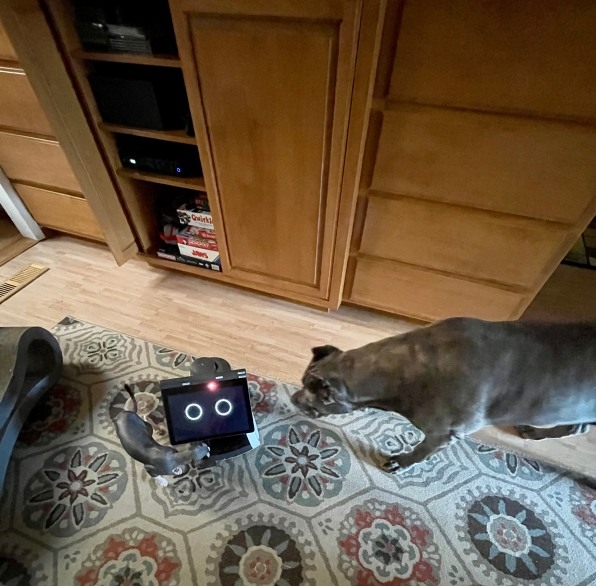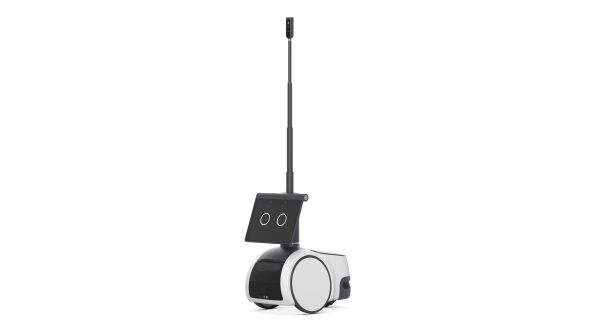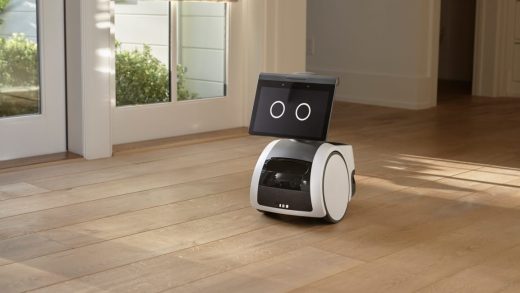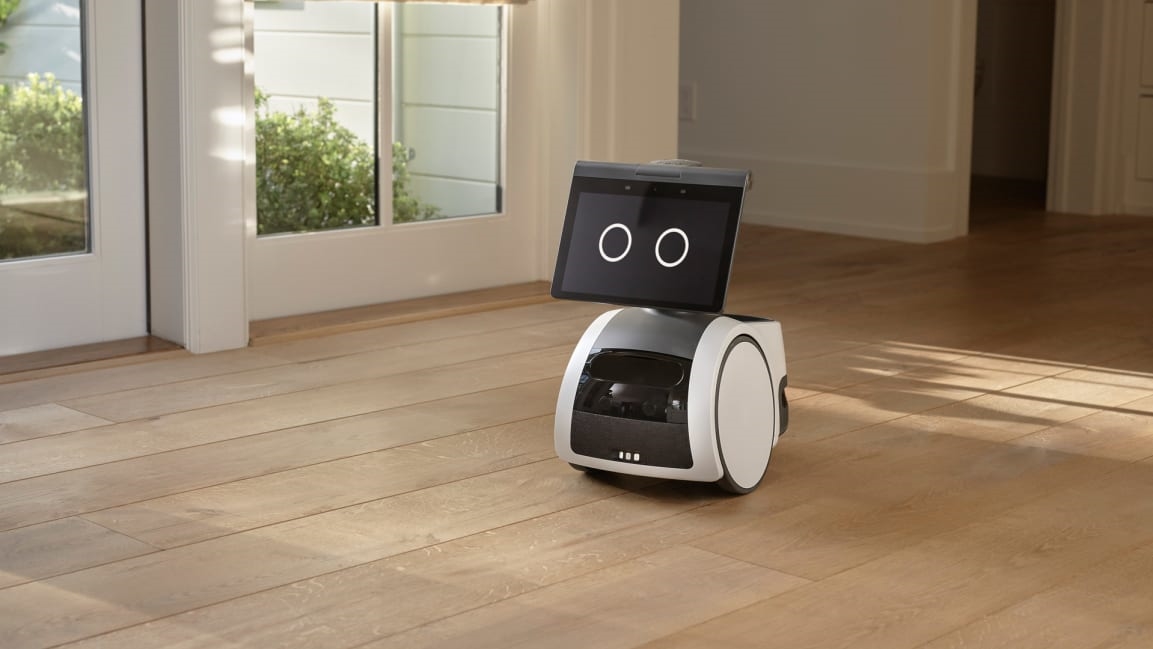Life with Astro: What it’s like to use Amazon’s robot in your own home
Before receiving the robot, I had to tell Amazon about the size of my house, whether there were stairs or sunken rooms, and if we had any ceiling-to-floor mirrors or glass doors—factors that impact the robot’s ability to initially map a household. We do have a sunken room and a ceiling-to-floor mirror. But my bigger concern was the fact that we have two large dogs and three cats. How would Astro fit into the menagerie and—most of all—survive our mastiffs?

When Astro arrived, it felt a little bit like what we went through with a new puppy. We had to find a spot for its charging station that was easy for it to get to but out of the way—once you set it, you can’t move it without remapping the house. It’s a safe space like a crate is to a puppy: You put it in a room so a pup (or robot) always knows where to go when it’s tired or needs a time-out.
As part of its setup process, Astro creates a map of the house so it can move around autonomously. Navigating the sunken room was pretty straightforward. The robot got to the steps, acknowledged them as a danger, moved back, and continued its mapping of the house, ignoring the sunken room altogether. The mirror we had in our corridor posed a little challenge, as Astro made the same mistake I made when we first saw our house: It thought the corridor was double its actual length. Covering up the bottom part of the mirror solved the problem, and Astro mapped the rest of the house perfectly.
Watching Astro go through the rooms, go back to the charging station, and then go out again was fascinating. Once the map was done Astro followed me around the house, and I named each room so it would know where to go if I gave it a command to go to “the office” or “the bedroom.”
After Astro had completed its mapping process, the sunken room and mirror didn’t stop it from getting around the house without any accidents. (Vice has published internal Amazon memos in which engineers worried about the robot flinging itself down stairs.)
While the house must be tidy and well lit for Astro to do its initial mapping, we were our normal messy selves after that. Astro happily navigated through dog toys and curious cats who would zigzag in front of it trying to figure out what it was. The speed at which the robot traveled varied considerably depending on whether the course in front of it was clear or not. If I asked Astro to follow me and I intentionally picked a route that had obstacles, it would err on the side of caution and pick an alternative route if it did not think it had enough room to turn safely. It was like watching a toddler learning to walk, processing information before moving ahead.
There were quite a few moments in which Astro was very endearing. One time I picked it up because I wanted to recenter it in a room and the screen displayed the message “Oh oh, I was picked up, let me know when I am safely on the ground again.” The robot’s beverage holders became a cat carrier at one point as our most adventurous kitten happily climbed up on it and went for a ride—a move that would come as no surprise to any Roomba.
When Astro recognizes you (or doesn’t)
As with any other Alexa-enabled device, I linked Astro to my Amazon account and added it to the other Echo devices I have, which let me communicate with Astro when it was in another room. As part of the setup, I also registered my face so I could have personalized greetings and information. In the morning, when I entered the room Astro was in, I would get a cheery “Good morning, Carolina!!” displayed on its screen. If I asked Astro how it was doing, I would get a few cheerful sounds and eye blinks. Cute factor aside, registering my face allowed Astro to locate me in the home.
My husband, however, is not keen on giving his biometrics to large tech corporations—even though I explained to him that Astro’s face prints are stored on the device, not in the cloud. For that reason, and for research purposes, we didn’t register his face with Astro. Because the robot was a prerelease device that I didn’t own, I also didn’t feel comfortable leaving it patrolling the house unattended with all of our pets roaming free. So in order to test its patrol capability, I set my presence on “Away,” hid in a corner (so Astro could not see my face and change the settings to home), and asked my husband to enter the room where the robot was located.

Astro rolled up to him and showed on its screen that it was not sure who he was and it needed to investigate further. It engaged its periscope camera, found my husband’s face, and alerted me on my phone with a video feed and an intruder warning. An actual intruder might not be as patient as my husband was in letting Astro investigate without smashing its camera. But the process is not dissimilar to what one would go through with an in-home security monitoring service, with the added advantage that Astro can go to an intruder based on noises it detects.
At the end of the two-week trial, I was left with mixed feelings about Astro. I was impressed with the autonomous navigation skills it displayed. I was enamored with its WALL-E like cuteness. I was convinced there could be a role for Astro to play in home monitoring and to help care for loved ones using Amazon’s new Alexa Together service. And the $1,000 price is reasonable given how much technology it packs, though Amazon might eventually sell it for less if the robot exits its current invite-only status and becomes a mainstream product.
As for Astro’s on-board cameras—which have raised concerns about AI-powered surveillance—I wasn’t bothered. It streams what it sees to the cloud only when you’ve set it to Away mode, just as more conventional security cameras do. (My husband, however, was less comfortable with Astro capturing its surroundings on video; he doesn’t like cameras of any kind in the house.)
Ultimately, I was unsure about how I would use Astro in my daily life. Mostly, that’s because we have an Echo or a Google device in every room already, so I don’t need Astro to follow me around playing music or wait for me to say something to Alexa. Actually, I wanted Astro to have its own voice rather than just offering access to Alexa: Reading the messages on the robot’s screen was not always the most practical thing to do. (Astro will launch with an accessibility feature that will read those messages out loud.)
What did my dogs think of Astro? They discovered that it’s sturdier than it looks (even my 146-pound mastiff couldn’t knock it over). They also learned that—as cute as it was—Astro wasn’t going to take their place.
Carolina Milanesi is principal analyst at Creative Strategies and founder of the Heart of Tech, a tech consultancy focused on education and diversity. She has been covering consumer tech for more than 15 years.
(60)



